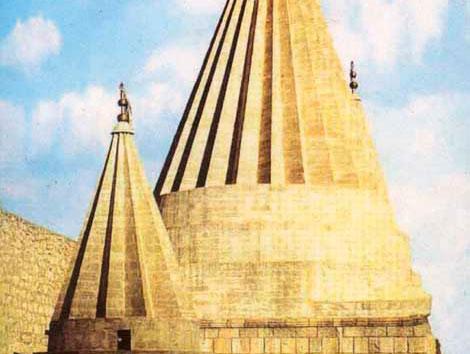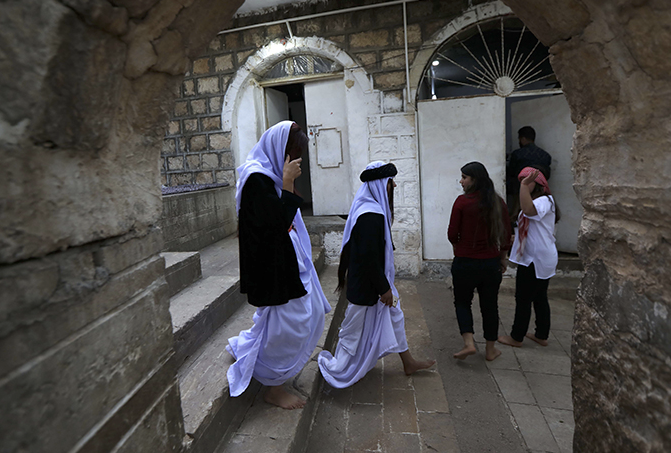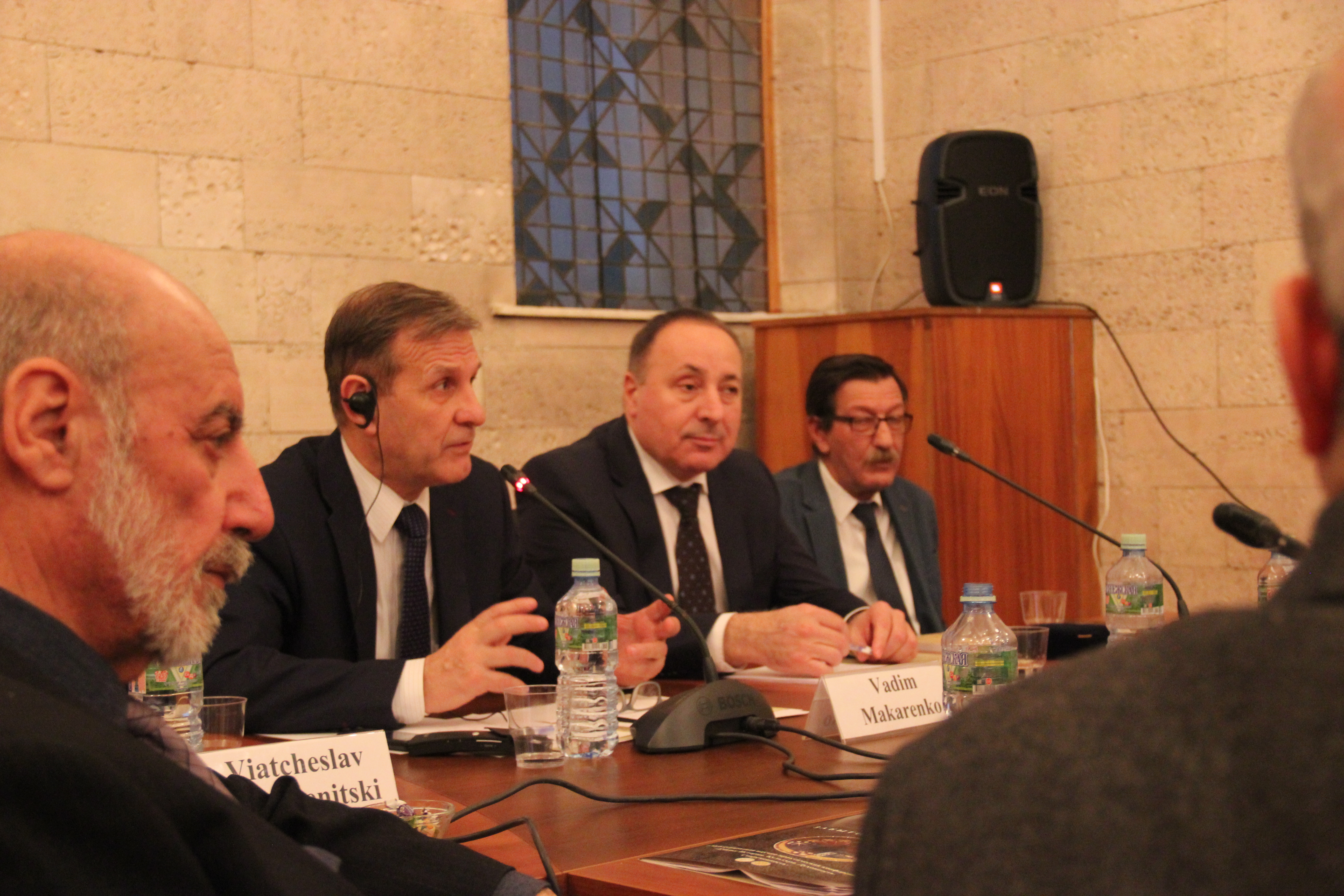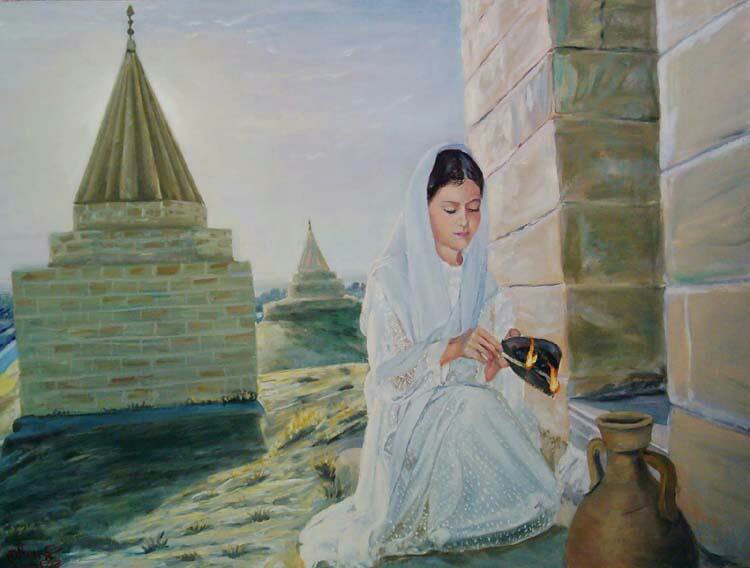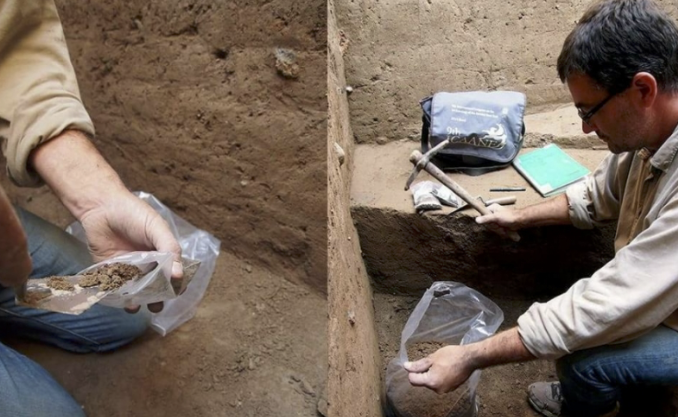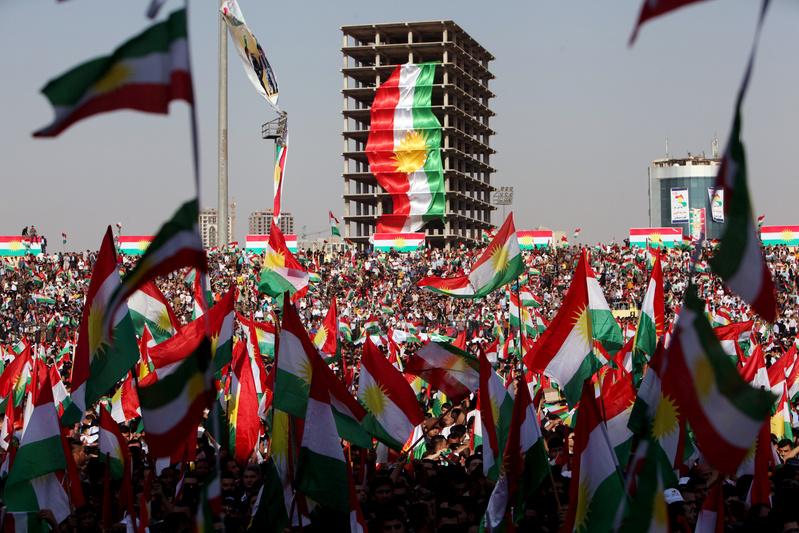Articles
A brief survey of The History of the Kurds
Kendal Nezan / 31 октября 2017 года
Who Are the Kurds?
Brushing over a depiction of 25 centuries of history in half an hour is obviously a tough task. That means about one minute per century! In this quick skimming through 1 can limit myself to merely pointing out a few major landmards and mentioning facts likely to help in the understanding of the present situation of the Kurds. 1 hope the specialists present here won't hold this approach of reducing and simplifying against me and, in response to questions raised during the discussion, I'd be happy to consider any aspect, which seems to you to have been insufficiently covered, in more depth.
The first question which comes to mind is that of the origins of the Kurds. Who are they? Where do they come from? Historians generally agree to consider them as belonging to the Iranian branch of the large family of Indo-European races. In prehistoric times, kingdoms called Mitanni, Kassites and Hourites reigned these mountainous areas, situated between the Iranian plateau and the Euphrates. In VII BC, the Medes, the Kurds' equivalent of the Gauls for the French, founded an empire which, in 612 BC, conquered the powerful Assyria and spread its domination through the whole of Iran as well as central Anatolia. The date 612, is moreover, considered by Kurdish nationalists as the beginning of the 1st Kurdish year; for them we are at present in 2601!
The political reign of the Medes was to end towards the end of 6 BC, but their religion and civilization were to dominate Iran until the time of Alexander the Great. From this date right until the advent of Islam, the fate of the Kurds, who geographers and Greek historians call Karduchoi, was to remain linked to that of the other populations of the empires which succeeded one another on the Iranian scene: Seljuks, Parthes and Sassanids.
Having put up fierce resistance to the Arabo-Muslim invasions, the Kurds ended up joining Islam, without, as a result, becoming Arabized. This resistance continued for about a century. The Kurdish tribes resisted the Arab tribes for social rather than religious reasons. All methods were used to coax the Kurds and convert them to Islam, even, for example, the matrimonial strategy, the mother of the last Omayyad caliph, Marwan Hakim, was Kurdish.
Due to the weakening of the caliphs' power, the Kurds, who already had a key role in the arts, history and philosophy fields, begin to assert, from the middle of the IXth century onwards, their own political power. In 837, a Kurdish lord, of the name Rozeguite, founds the town of Akhlat on the banks of Lake Van and makes it the capital of his principality, theoretically vassal of the caliph, but in actual fact virtually independent. In the second half of the Xth century Kurdistan is shared amongst 4 big Kurdish principalities. In the North, the Shaddadids, (951-1174), in the East, the Hasanwayhids (959-1015) and the Banu Annaz (990-1116) and in the West the Marwanids (990-1096) of Diyarbakir. One of these dynasties would have been able, during the decades, to impose its supremacy on the others and build a state incorporating the whole Kurdish country if the course of history hadn't been disrupted by the massive invasions of tribes surging out of the steppes of Central Asia. Having conquered Iran and imposed their yoke on the caliph of Baghdad, the Seljuk Turks annexed the Kurdish principalities one by one. Around 1150, the sultan Sandjar, the last of the great Seljuk monarchs, created a province from Kurdistan.
Up until then the Kurds' lands were cal - led the Media by Greek geographers, the "Djibal", which means the mountain for the Arabs. It's thus a Turkish sultan who, in homage to the distinctive personality of the Kurdish country, gives it the name Kurdistan. The province of Kurdistan, formed by Sandjar, had as its capital the village Bahâr (which means spring), near ancient Ecbatane, capital of the Medes. It included the vilayets of Sindjar and Shahrazur to the west of the Zagros massif and those of Hamadan, Dinaver and Kermanshah to the east of this range. Thus, as a whole this designation only recovered a southern part of ethnic Kurdistan. A brilliant autochthonous civilization developed around the town of Divaver-today ruined - 75km North-East of Kermanshah, whose radiance was than partially replaced by that of Senna, 90km further North.
Only about twelve years after the disappearance of the last great Seijuk, a Kurdish dynasty, that of the Ayyubids (1169-1250), founded by the famous Saladin emerges and takes over the leadership of the muslim world for about a century, until the Turko-Mongolian invasions of the XIIIth century. The high-ranking figure of Saladin and his exploits against the crusaders are sufficiently well-known in Europe. His empire incorporated, as well as almost the whole of Kurdistan, all Syria, Egypt and Yemen. It was a bit like the Germanic Roman Empire claiming to reassemble peoples, kingdoms and principalities of Catholic Europe. It was the time of the Crusades, of the hegemony of the religious on the political and the national. Saladin was, thus, no more of a Kurdish patriot than Saint Louis was a French nationalist.
With the emergence of Kurdistan as a recognized geographical entity, the supremacy of a Kurdish dynasty on the muslim world and the blossoming of an important written literature in the Kurdish language, the XIIth century is assuredly a rich period in the events of Kurdish history. It's also during the course of this century that the Nestorian church with its metropolitan centre in Kurdistan, develops with extraordinary rapidity, its missions spreading across the whole of Asia, as far as Tibet, Sin Kiang, Mongolia and Sumatra. The most spectacular success of these missions was the conversion of the great Mongolian Khan Guyuk in 1248. Also in 1253, Saint Louis sent Guillaume de Rubrouck, who played an important role in what was called the "Mongolian crusade" to him in Baghdad. In 1258, when the Mongolian Hulagu, influenced by these missions, takes Baghdad, he puts the caliph to death but sees to it that the palace is given to the Nestorian Catholics. At the end of the XIIIth century, Islam gains the upper hand over the Mongolians and the Nestorians are massacred. The centre of their patriarchate moves in the course of the centuries but still remains in Kurdistan.
In the second half of the XVth century the Kurdish country ends up by recovering from the effects of the Turko-Mongolian invasions and by taking the form of an autonomous entity, united by its language, culture and civilization, but politically split up into a series of principalities. However, at least amongst the well-read, there's a keen awareness of belonging to a single country. A XVIth century poet, Melaye Djaziri, from the principality of Bohtan, considered as the Kurdish Ronsard introduces himself in these terms:
I am the torch of the nights of Kurdistan.
At the beginning of the XVIth century the Kurdish country becomes the main stake of the rivalties between the Ottoman and Persian empires. The new shah of Persia, who has imposed Shfisme as the state religion, tries to spread it across the neighbouring countries. The Ottomans, from their side, want to put a stop to the shah's expansionist aims and to assure their Iranian border in order to be able to embark on the conquest of the Arab countries. Caught in the pincer movement of the two giant powers, the Kurds, politically split, had no chance of surviving as an independent entity. In 1514, the Turkish sultan inflicted a bitter defeat on the shah of Persia. Fearing that his victory, would be short-lived, he looked for ways of assuring this difficult Iranian border permanently. At this point one of his most valued advisors, the Kurdish scholar, Idrissi Bitlissi, came up with the idea of recognizing all the former rights and privileges of the Kurdish princes in exchange for a commitment from the latter to guard this border themselves and to fight at the side of the Ottomans in the case of a Persan-Ottoman conflict. The Turkish sultan Selim the 1st gives his support to the plan of his Kurdish advisor, who went to see the Kurdish princes and lords one by one to convince them that it was in the interest of the Kurds and the Ottomans to conclude this alliance.
Confronted with the choice of being annexed at some point by Persia or formally accepting the supremacy of the Ottoman sultan in exchange for a very wide autonomy, the Kurdish leaders opted for this second solution and thus Kurdistan, or more exactly its countless fiefs and principalities entered the Ottoman bosom by the path of diplomacy. Idrissi Bidlissi's mission was facilitated by the fact that he was a well-known and respected scholar and, above all, by the immense prestige of his father, the Sheikh Hussameddin who was a very influential sufi spiritual chief. Bidlissi is also the author of the first treaty of the General History of the Ottoman Empire.
This particular status was to assure Kurdistan about three centuries of peace. The Ottomans controlled some strategic garrisons on the Kurdish territory, but the rest of the country was governed by the Kurdish lords and princes. As well as a string of modest hereditary seigniories, Kurdistan totalled 17 principalities of hukumets possessing a wide autonomy. Someof them for example those of. Ardalan, Hisn Kaif' Bohtan, and Rowanduz were endowed with attributes of independence. Despite interferences from time to time from the central power, this particular status, to the satisfaction of the Kurds and the Ottomans, functioned without any major hitch until the beginning of the XIXth century. The Ottomans, protected by the powerful Kurdish barrier against Iran, were able to concentrate their forces on other fronts. As for the Kurds, they were virtually independent in the management of their affairs. They lived in seclusion of course and their country was split amongst a series of principalities, but in this same era Germany totalled some 350 autonomous states and Italy was much more broken up than Kurdistan. Every Kurdish court was the centre of an important literary and artistic life. And as a whole, despite the political division, this period in fact constitutes the golden age of Kurdish literary, musical, historical and philosophical creation. In 1596, prince Sheref Khan finishes his monumental "Sherefnamch or splendours of the Kurdish nation". The theological schools of Chre and Zakho are renowned in the entire muslim world, the town of Akhlat endowed with an observatory is known for its teaching of natural sciences, masters of suffism like are revered even in Istanbul for their spiritual teaching and their musical genius. Certain ambitious Kurds such as the poets Nabi, Nefi, write in Turkish to win the favour of the sultan.
With the exception of some visionary spirits like the great XVI I th century Kurdish poet, Ehmede Khani, the well-read Kurds and Kurdish princes seem to believe that their status is going to last eternally and feel no need to change it. In 1675, more than a century before the French Revolution, which spreads the idea of the nation and the state-nation in the West, the poet Khani, in his epic in verse "Mem-o-Zin", calls the Kurds to unite and create their own unified state. he'll scarcely be listened to by either the aristocracy or the population. On Islamic ground, like elsewhere at the same epoch of Christianity, the religious conscience generally prevails over the national conscience. Every prince is preoccupied by the interests of his dynasty, and family, clan or dynastic dynamics often count more than any other consideration. It wasn't rare to see the Kurdish dynasties reign over the non-Kurdish populations. In the XIth century, for example, Farsistan, a Persian province par excellence, was governed by a Kurdish dynasty; from 1242 to 1378 Khorassan an Iranian province in the North-East also had a Kurdish dynasty, and from 1747 to 1859 this was the case for distant Baluchistan, which is to day part of Pakistan. So the fact that a certain proportion of the Kurdish territory is governed by foreign dynasties oughtn't seem unacceptable to contemporary people.
The idea of the nation-state and of nationalism is an avatar of the French Revolution. It quickly found a particularly prosperous ground in two divided countries and partly subjugated Germany and Italy. It's German thinkers such as Goerres, Brentano and Grimm who laid down the postulate in accordance with which the political, geographical and linguistic borders were to coincide. They dreamt of a Germany reassembling in one state the string of its small autonomous states. Pan-Germanism in turn inspired other nationalist movements such as pan Slavism and pan-Turkism. These ideas were to find success rather later on, towards 1830, in Kurdistan where the Prince of Rowanduz, Mir Mohammed, was to fight from 1830 to 1839 in the name of his ideas for the creation fo a unified Kurdistan.
In fact, up until then, since they hadn't been threatened in their privileges, the Kurdish princes contented themselves with administrating their domain, whilst, at the same time paying homage to the distant sultan-caliph of Constantinople. As a general rule, they weren't to rise up and attempt to create a unified Kurdistan until, at the beginning of the XIXth century, the Ottoman Empire interfered in their affairs and tried to bring and end to their autonomy.
Wars for the unification and independence of Kurdistan mark the first part of the XIXth century. In 1847, the last independent Kurdish principality, that of Bohtan, collapses. Sign of the times, the Ottoman forces, are advised and helped by European powers, in their fight against the Kurds. We notice, for example, the presence of Helmut von Moltke, at the time young captain and military advisor.
From 1847 to 1881, we observe new uprisings, under the leadershipof the traditional chiefs, often religious, for the creation of a Kurdish state. This will be followed, up until the First World War, by a whole series of sporadic and regional revolts against the central government, all of which will be harshly quelled.
The causes of the failure of these movements are multiple: breaking up of authority, feudal dispersal quarrels of supremacy between the princes and the feudal Kurds and interference of the major powers at the Ottoman's side.
Having annexed the Kurdish principalities one by one, the Turkish government applied itself to integrating the Kurdish aristocracy by distributing posts and payments fairly generously and by setting up so-called tribal schools, intended to instill in the children of Kurdish lords the principal of faithfulness to the sultan. This attempt to integrate à la Louis XIV was to an extent crowned with success. But it also furthered the emergence of elite Kurdish modernists. Under their leadership a modern phase in the political movement became apparent in Constantinople whilst charitable and patriotic associations and societies multiplied, trying to introduce the notion of organization and to set up a structured movement in the Kurdish population.
It's important to specify that at the end of the XIXth century the Ottoman Empire was prey to severe nationalist convulsions, each people aspired to the creation of its own nation state. Having tried in vain to keep this conglomeration alive by the ideology of pan-Ottomanism, then of pan-Islamism, the Turkish elite themselves became pan-Turkish and militated in favour of the creation of a Turkish empire going from the Balkans to Central Asia.
Kurdish society approached the First World War divided, decapitated, without a collective plan for its future. In 1915, the Franco-British agreements known as the Sykes-Picot forecast the dismemberment of their country. However the Kurds were in conflict over the destiny of their country. Some, very open to the "pan-Islamist ideology of the sultan-caliph, saw the salvation of the Kurdish people in a status of cultural and administrative autonomy within the frame of the Ottoman Empire. Others, claiming to take inspiration from the principle of nationalities, from the ideas of the French Revolution and from President Wilson from the United States, fought for the total independence of Kurdistan.
The split became accentuated in the days following the Ottoman defeat by the Allied Powers, in 1918. The independantists formed a hurried delegation at the Conference of Versailles to present "the claims of the Kurdish nation".
Theiraction contributed to the taking intoaccount by the International Community, of the Kurdish national question. The International Treaty of Sèvres, between the Allies: France, Great Britain and the United States, and the Ottoman Empire, concluded on the 10th of August 1920, actually recommended, in section 111 (art. 62-64), the creation of a Kurdish state on part of the territory of Kurdistan. This treaty was to go unheeded, however, the balance of power on the terrain preventing its application.
For its part, the traditional wing of the Kurdish movement, which was wellestablished in Kurdish society and which was mainly dominated by religious leaders, tried to "avoid Christian peril in the East and West" and to create "a state of Turks and Kurds" in the muslim territories liberated from foreign occupation. The idea was generous and fraternal. An alliance was concluded with the Turkish nationalist leader, Mustafa Kemal, who came to Kurdistan to seek the help of the Kurdish leaders to liberate occupied Anatolia and the sultan-caliph, who was a virtual prisoner of the Christians. The first forces of Turkey's war of independence were in fact recruited from the Kurdish provinces.
Up until his definitive victory over the Greeks in 1922, Mustafa Kemal continued to promise the creation of a muslim state of Turks and Kurds. He was openly supported by the Soviets, and more discreetly by the French and Italians, displeased with the excessive appetites of British colonialism in the region. After the victory, the Turkish delegates were to affirm, at the peace conference at Lausanne, that they spoke in the name of the Kurdish and Turkish sister nations. On 24th July 1923, a new treaty was signed in this context between the Kemalist government of Ankara and the allied powers. It invalidated the Treaty of Sèvres and, without giving any guarantee, with regard to the respect of the Kurds' rights, gave the annexation of the major part of Kurdistan over to the new Turkish state. Beforehand, in accordance with the Franco-Turkish agreement of October 20, 192 1, France had annexed the Kurdish provinces of Jazira and Kurd-Dagh to Syria, which were placed under its mandate. Iranian Kurdistan, a large part of which was controlled by the Kurdish leader Simko, lived in a state of near dissidence with regard to the Persian central government.
The fate of the Kurdish province of Mossul, very rich in petrol remained undecided. The Turks and the British claimed it, whilst its population, during a consultation organized by the Society of Nations, reached a decision, in a proportion of 718, in favour of an independent Kurdish state. Protesting that the Iraqi state wouldn't be able to survive without the agricultural and petroleum wealth of this province, Great Britain ended up obtaining the annexation of these Kurdish territories with Iraq placed under its mandate, from the League of Nations Council on December 16th, 1925. It nevertheless promised the setting up of an autonomous Kurdish government, a promise kept neither by the British, nor the Iraqi regime, which succeeded the British administration in 1932.
Thus at the end of 1925, the country of the Kurds, known since the XIIth century by the name "Kurdistan", found itself divided between four states: Turkey, Iran, Iraq and Syria. And for the first time in its long history, it was even to be deprived of its cultural autonomy.
The former conquerors and empires contented themselves with certain economic, political and military advantages and privileges. None of them set about preventing the population from expressing its cultural identity or hindering the free practice of its spiritual life. None of them devised a plan to destroy the Kurdish personality or to depersonalize an entire race by cutting it off from its ancient cultural roots.
This was the project of the Turkish nationalists, who wanted to make Turkey, an eminently multicultural, multiracial and multinational society, into a uniform nation; this was later taken up again by Iraq and Iran. We can join Nehru in his surprise "that a defensive nationalism turns into an aggressive nationalism and that a struggle for freedom becomes a struggle to dominate others". Indeed, since these lines were written by Nehru from the depths of prison, the nationalist or messianic ideologies have caused other ravages under other skies, often in the name of progress, modernity, mission of civilization, even freedom. Victim of its geography, of history and also, undoubtedly of its own leaders' lack of clear-sightedness, the Kurdish people have undoubtedly been the population who have paid the heaviest tribute and who have suffered the most from the remodeling of the Near-Eastern map. To paraphrase a formula formerly used for Poland, I'll say that since the dividing up of Kurdistan, the Near-East has been a sinner against itself and this sin hasn't finished poisoning its relations.
Источник: institutkurde.org

